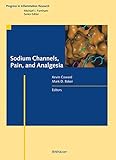Sodium Channels, Pain, and Analgesia / edited by Michael J. Parnham, Kevin Coward, Mark D. Baker.
Tipo de material: TextoSeries Progress in Inflammation ResearchEditor: Basel : Birkhäuser Basel, 2005Descripción: Ix, 199 páginas recurso en líneaTipo de contenido:
TextoSeries Progress in Inflammation ResearchEditor: Basel : Birkhäuser Basel, 2005Descripción: Ix, 199 páginas recurso en líneaTipo de contenido: - texto
- computadora
- recurso en línea
- 9783764374112
- RB127
Springer eBooks
Voltage-gated sodium channels and pain associated with nerve injury and neuropathies -- Current approaches for the discovery of novel NaV channel inhibitors for the treatment of brain disorders -- Voltage-gated sodium channels and visceral pain -- The functional interaction of accessory proteins and voltage-gated sodium channels -- Sodium channels and nociceptive nerve endings -- Signalling cascades that modulate the activity of sodium channels in sensory neurons -- NaV1.8 as a drug target for pain -- Role of voltage-gated sodium channels in oral and craniofacial pain -- Sodium channel gating and drug blockade -- Future directions in sodium channel research.
Sodium channels confer excitability on neurons in nociceptive pathways and exhibit neuronal tissue specific and injury regulated expression. This volume provides recent insights into the control of expression, functioning and membrane trafficking of nervous system sodium channels and reviews why sodium channel sub-types are potentially important drug targets in the treatment of pain. The roles of sodium channels in dental and visceral pain are also addressed. The emerging role of sodium channel Nav1.3 in neuropathic states is another important theme. Authors from the pharmaceutical industry discuss pharmacological approaches to the drug targeting of sodium channels, and in particular Nav1.8, exclusively expressed in nociceptive neurons. The final chapter highlights the functional diversity of sodium channels in part provided by post-transcriptional processing and the insights into sodium channel function that are being provided by tissue specific and inducible gene knock-out technology.
Para consulta fuera de la UANL se requiere clave de acceso remoto.


